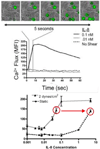E-selectin ligands as mechanosensitive receptors on neutrophils in health and disease
- PMID: 22271244
- PMCID: PMC3680630
- DOI: 10.1007/s10439-011-0507-y
E-selectin ligands as mechanosensitive receptors on neutrophils in health and disease
Abstract
Application of mechanical force to bonds between selectins and their ligands is a requirement for these adhesion receptors to optimally perform functions that include leukocyte tethering and activation of stable adhesion. Although all three selectins are reported to signal from the outside-in subsequent to ligand binding, E-selectin is unique in its capacity to bind multiple sialyl Lewis x presenting ligands and mediate slow rolling on the order of a micron per second. A diverse set of ligands are recognized by E-selectin in the mouse, including ESL-1, CD44 (HCELL), and PSGL-1 which are critical in transition from slow rolling to arrest and for efficient transendothelial migration. The molecular recognition process is different in humans as L-selectin is a major ligand, which along with glycolipids constitute more than half of the E-selectin receptors on human polymorphonuclear neutrophils (PMN). In addition, E-selectin is most efficient at raising the affinity and avidity of CD18 integrins that supports PMN deceleration and trafficking to sites of acute inflammation. The mechanism is only partially understood but known to involve a rise in cytosolic calcium and tyrosine phosphorylation that activates p38 MAP kinase and Syk kinase, both of which transduce signals from clustered E-selectin ligands. In this review we highlight the molecular recognition and mechanical requirements of this process to reveal how E-selectin confers selectivity and efficiency of signaling for extravasation at sites of inflammation and the mechanism of action of a new glycomimetic antagonist targeted to the lectin domain that has shown efficacy in blocking neutrophil activation and adhesion on inflamed endothelium.
Conflict of interest statement
J.L.M. is the head of research at Glycomimetics, Inc. and has a financial interest in developing the selectin antagonist GMI-1070. S.I.S. and UC Davis are participating in a Phase I–II clinical study of GMI-1070 for the treatment of vaso-occlusion in sickle cell patients, but have no other financial interest in Glycomimetics, Inc.
Figures



Similar articles
-
Neutrophils exposed to A. phagocytophilum under shear stress fail to fully activate, polarize, and transmigrate across inflamed endothelium.Am J Physiol Cell Physiol. 2010 Jul;299(1):C87-96. doi: 10.1152/ajpcell.00165.2009. Epub 2010 Apr 14. Am J Physiol Cell Physiol. 2010. PMID: 20392928 Free PMC article.
-
Shear-dependent capping of L-selectin and P-selectin glycoprotein ligand 1 by E-selectin signals activation of high-avidity beta2-integrin on neutrophils.J Immunol. 2004 Jun 15;172(12):7780-90. doi: 10.4049/jimmunol.172.12.7780. J Immunol. 2004. PMID: 15187162
-
Selectin catch-bonds mechanotransduce integrin activation and neutrophil arrest on inflamed endothelium under shear flow.Blood. 2017 Nov 9;130(19):2101-2110. doi: 10.1182/blood-2017-05-783027. Epub 2017 Aug 15. Blood. 2017. PMID: 28811304 Free PMC article. Clinical Trial.
-
Leukocyte ligands for endothelial selectins: specialized glycoconjugates that mediate rolling and signaling under flow.Blood. 2011 Dec 22;118(26):6743-51. doi: 10.1182/blood-2011-07-343566. Epub 2011 Oct 20. Blood. 2011. PMID: 22021370 Free PMC article. Review.
-
Reprint of Neutrophil cell surface receptors and their intracellular signal transduction pathways.Int Immunopharmacol. 2013 Dec;17(4):1185-97. doi: 10.1016/j.intimp.2013.11.010. Epub 2013 Nov 18. Int Immunopharmacol. 2013. PMID: 24263067 Review.
Cited by
-
Leukemia Mediated Endothelial Cell Activation Modulates Leukemia Cell Susceptibility to Chemotherapy through a Positive Feedback Loop Mechanism.PLoS One. 2013;8(4):e60823. doi: 10.1371/journal.pone.0060823. Epub 2013 Apr 1. PLoS One. 2013. PMID: 23560111 Free PMC article.
-
The role of galectins in mediating the adhesion of circulating cells to vascular endothelium.Front Immunol. 2024 May 22;15:1395714. doi: 10.3389/fimmu.2024.1395714. eCollection 2024. Front Immunol. 2024. PMID: 38840921 Free PMC article. Review.
-
Process of hepatic metastasis from pancreatic cancer: biology with clinical significance.J Cancer Res Clin Oncol. 2016 Jun;142(6):1137-61. doi: 10.1007/s00432-015-2024-0. Epub 2015 Aug 7. J Cancer Res Clin Oncol. 2016. PMID: 26250876 Free PMC article. Review.
-
Dormant breast cancer micrometastases reside in specific bone marrow niches that regulate their transit to and from bone.Sci Transl Med. 2016 May 25;8(340):340ra73. doi: 10.1126/scitranslmed.aad4059. Sci Transl Med. 2016. PMID: 27225183 Free PMC article.
-
P- and E- selectin in venous thrombosis and non-venous pathologies.J Thromb Haemost. 2022 May;20(5):1056-1066. doi: 10.1111/jth.15689. Epub 2022 Mar 25. J Thromb Haemost. 2022. PMID: 35243742 Free PMC article. Review.
References
-
- Bevilacqua MP, Stengelin S, Gimbrone MA, Jr, Seed B. Endothelial leukocyte adhesion molecule 1: an inducible receptor for neutrophils related to complement regulatory proteins and lectins. Science. 1989 Mar 3;243:1160. - PubMed
-
- Johnston GI, Cook RG, McEver RP. Cloning of GMP-140, a granule membrane protein of platelets and endothelium: sequence similarity to proteins involved in cell adhesion and inflammation. Cell. 1989 Mar 24;56:1033. - PubMed
-
- Lasky LA, et al. Cloning of a lymphocyte homing receptor reveals a lectin domain. Cell. 1989 Mar 24;56:1045. - PubMed
-
- Siegelman MH, van de Rijn M, Weissman IL. Mouse lymph node homing receptor cDNA clone encodes a glycoprotein revealing tandem interaction domains. Science. 1989 Mar 3;243:1165. - PubMed
Publication types
MeSH terms
Substances
Grants and funding
LinkOut - more resources
Full Text Sources
Other Literature Sources
Miscellaneous

